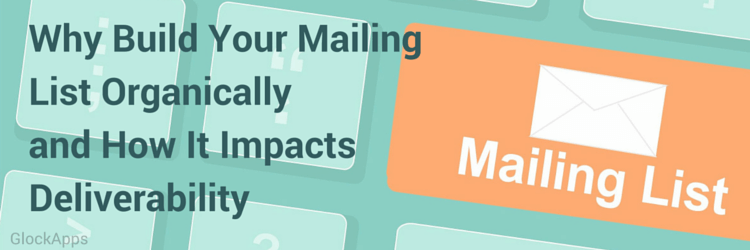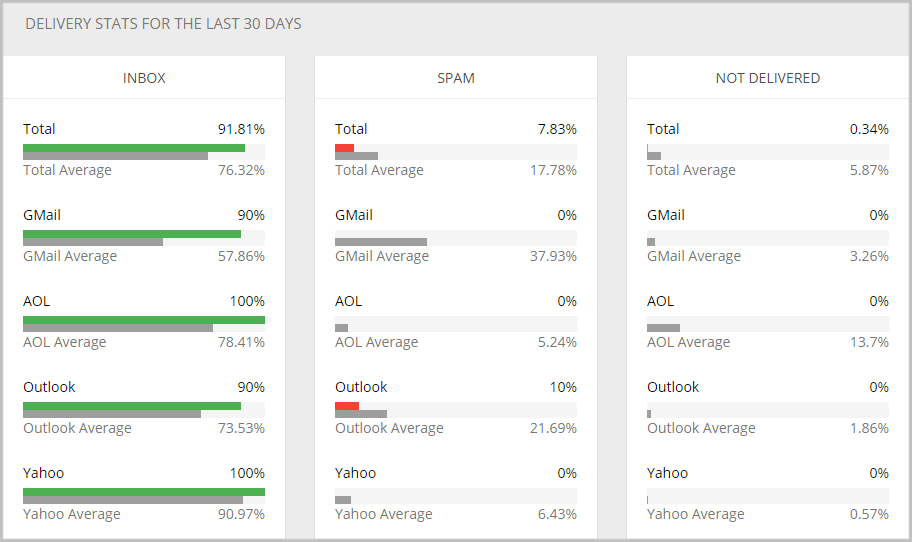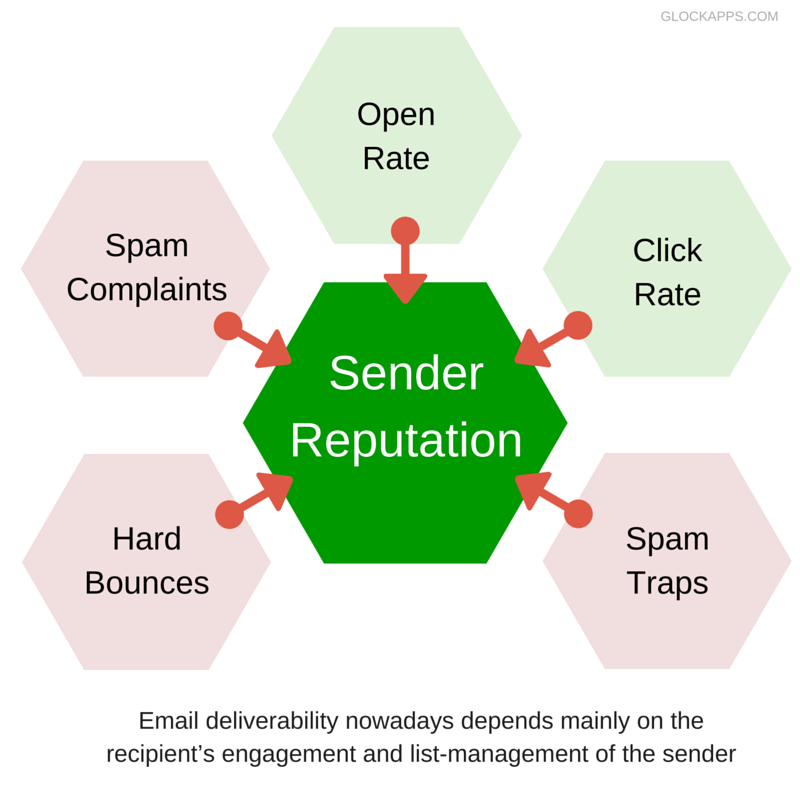5 Reasons You Need to Grow Your Email List Organically in 2023
Deliverability is the cherished dream of email marketers. You only waste your time and money that you spent for preparing and sending an email campaign if your email doesn’t reach your subscriber’s Inbox.
GlocApps tracks and reports on deliverability with its Inbox and spam rate metric. Very few email marketers achieved the Inbox Placement rates of at least 90%. The average of Inbox Placement performance for the last 30 days is 76%, calculated based on the email activity of all our customers.
Why does this number matter so much? If you send one million emails, for every 1% you improve your Inbox Placement rate, you get 10,000 more emails to your recipients’ Inboxes, and that makes a lot more opportunities for your email to be opened, read and acted on.
Managing email deliverability is a science because, in the modern email marketing, content does not matter as much as it was before. Spammers easily trick content filters.
Nowadays, mailbox providers and spam filtering systems evaluate your sending reputation and recipient engagement when making Inbox and spam folder placement decisions. If you have a good reputation, in most cases your reputation will beat any content issues.
There are tools like this free email spam checker that you can use to test your reputation, authentication, spam score and deliverability prior sending a real email campaign.
Your sender reputation is determined by the quality of your email lists, complaints, bounces, spam trap hits, subscriber engagement (opens, clicks, spam markings, deletions), and email/domain reputation.
Below, we’ll talk about one aspect of email marketing that is often underestimated by marketers, but that directly impacts whether or not your email is delivered to the Inbox. It’s the mailing list.
Why Grow Email List Organically
Working for more than 15 years in the email marketing industry, one of the most important lessons we have learned is that an organically grow email list is the key prerequisite for high deliverability.
Sending to borrowed, scraped, or purchased lists can do more harm to you than you think.
So, if you want to send effective email marketing campaigns, then be patient and grow your list organically.
There are at least five reasons for this:
1. Organic List Gives You Better Deliverability.
If you send to a list of people who subscribed to receiving your email, the chances for the email addresses to be valid are higher. Thus, the chances for your emails to reach the recipients are higher.
Many of the scraped or purchased lists contain fake or disposable email addresses that people use simply to sign up and receive some free content or participate in a giveaway. They’re not looking for receiving emails after they signup.
Needless to say that scraped or purchased lists often contain a lot of invalid email addresses that will generate bounce messages.
2. Organic List Gives You Better Open and Conversion Rates.
It is evident, but some marketers overlook it. In addition to better deliverability when emails are actually reaching the target recipients, organic lists give you better open rates.
An organic list is a much more engaged list. That is because organic lists give you the audience that wants to see what you have to offer and the likelihood that the email will be opened, read and acted on is higher.
With a scraped or bought list, you’re sending emails to people who have not had any previous interaction with your brand and don’t have a clue who you are and why you are sending emails to them. Why would they want to read your email then?
3. Organic List Allows You to Measure True Success or Failure of Your Campaign.
Imagine that you purchased an email list and the selling company said that the recipients are your target audience. You prepared a great offer that is likely to convert, you created a beautiful email newsletter and sent it to the purchased list.
If your open rate is very low and conversion rate is zero, can you really know whether your email copy was not good or your offer was not attractive enough? No.
Your email newsletter and offer may be the best ones ever and might attract a lot of recipients, “targeted recipients.” But if only 0,01% of the recipients on your purchased list opened your email and none of them took your offer, then you will think that your email copy and offer are not effective.
Now, let’s say you have an organic list that you collected on your own through a subscription form on your website or landing page. You use the same email newsletter and same offer and send it out.
This time, you can measure true conversion and determine the problem if your campaign fails. If your open rate is low, the issue is likely in the Subject that was not teasing enough. If the open rate is good but conversions are low, it turns our that your offer was not relevant or not seducing. After all, people reading your email are ready to act.
4. Organic List Protects Your Sender Reputation.
One of the essential factors that builds your reputation as a sender is subscriber engagement. Mailbox providers monitor how their users treat email messages – whether they are opening or deleting emails, moving emails to the spam folder or from spam to Inbox, reporting a spam complaint or replying the sender. All the user’s actions are evaluated and used to calculate the sender reputation and apply a filtering algorithm to future messages coming from the sender.
Scraped and purchased email lists are likely to generate a lot of negative actions. If an email address is publicly published, it’s already been scraped by a lot of people and sent tons of spam. If a live person is still using that email address, they’re probably tired of spammers and will report your message as spam or delete it without opening. It has a negative impact on your sender reputation and future deliverability.
Another big problem with scraped and bought email lists are spam traps and bounce addresses. Hitting a spam trap is the worst thing that may happen to you because it leads to blacklisting issues.
And bounce addresses are not as inoffensive as they seem. A high bounce rate is a sign of a bad list acquisition and management practices. If you are sending emails through an email service provider or delivery service and you did not verify your scraped or bought list, don’t be surprised to see your account suspended after the very first mailing because of a high bounce rate. An acceptable rate for hard bounces is under 5% of the total emails sent.
Also, big email service providers that care about their reputation and strive to guarantee high deliverability to all their users won’t even allow you to upload your email list if you don’t prove that it is an opt-in list.
If you are using an in-house email system with your own mail server, you are putting your mail server’s reputation at risk by sending email campaigns that have a big potential to generate a lot of bounces.
5. Organic List Protects You at the Legislative Level.
Although permission is not a requirement under the U.S. law, it is certainly a best practice considering the reasons we covered above.
In many other countries, however, senders must have permission to send marketing and commercial email. For example, in Argentina, Australia, Belgium, France, Germany, Italy, Canada, and Hong Kong an opt-in is required and an explicit consent of the recipient to receive emails is a must.
Growing an organic list certainly takes more time and efforts than scraping or purchasing the list. But in the long run, it will be paid off. After all, a 0,1% open rate with a purchased list gives you fewer conversions than an organically built list with 50% open rate.
How to Grow and Maintain List Organically
So, what’s the best way to grow a list?
Here are seven sure-fire tips you can follow right now to grow your own quality list of email subscribers and maintain it clean and responsive:
1. Use Subscription Form on Your Web Site or Landing Page.
Your recipient should knowingly subscribe to receive your emails. There is a debate what is better: a single or confirmed opt-in method. We recommend using a confirmed opt-in process because:
it reduces the number of invalid addresses resulting from typos;
it excludes malicious and erroneous subscriptions;
it builds a more quality list.
Of course, a confirmed opt-in method requires an additional action from the subscriber, but people who are truly interested in what you have to offer will not mind to take that extra step and confirm their subscription.
2. Entice Existing Customers to Subscribe.
If you let people download a free trial or sign up for a free account on your website, send them an onboarding email after they downloaded the trial or created an account. In the email, you can thank them for trying your product or service, include links to tutorials, FAQ or other useful resources and invite them to your opt-in page or form.
You can also include a link to the subscription form into your registration email you send to your buyers after they made a purchase with you.
3. Avoid Pre-Checked Opt-In Boxes.
In Netherlands, pre-checked boxes are not allowed as a mode of consent. In other countries, it may be legal, but we still do not recommend that you automatically send marketing emails to people if they’re not formally opted-in.
Also, companies often use a passive opt-in process when a user must check an empty box if they don’t want to subscribe to mailings. People often fill the form on auto-pilot and get subscribed without giving an explicit consent. In the future, such a passive opt-in process can result in a high complaint rate.
4. Send Welcome Email to New Opt-Ins.
The welcome message helps confirm and activate the new relationship, and it can also determine deliverability problems before they affect your Inbox placement rate and sender reputation.
5. Remove Distribution and Role Email Addresses.
Certain email addresses are set up to have a specific function within an organization and are intended only to receive messages related to that function. For example, “abuse@XYZ.com” is the email address a company uses to receive email abuse reports.
Because such accounts are tied to specific functions in a company, they’re not intended for personal use such as subscribing to email marketing communications. Aside from being an annoyance, this also raises the likelihood that somebody in the organization will report your messages as spam. That can hurt your email deliverability.
Thus, you should review your opt-in list, spot distribution and role email addresses and remove them from your mailing list.
6. Maintain the List Clean and Active.
List management best practices that you should perform on a regular basis include:
- handling of bounce emails;
- handling of unsubscribed and complaining users;\
- detection and suppression of inactive users.
As a rule, email service providers automatically process bounce, unsubscribes and complaints for you. But if you are using a self-hosted email solution like EasyMail7, you have to set it up yourself so that it handles those messages for you, or outsource this work to a 3rd party service.
With that said, it is a good idea to sign up for feedback loops with ISPs to get notified of spam complaints when they happen.
It is also useful to identify the subscribers who haven’t opened your emails for 12 months or more, and remove them from a mailable list. Send a re-optin email to them and continue marketing to only those users who re-opted in.
7. Allow Them to Change Their Email Address.
We all know that people often change their email addresses. You should make it easy for them to update their contact information without the need to unsubscribe and re-subscribe with the new email. Many unsubscribers are really only trying to change their email addresses when they choose to unsubscribe.
That’s it. Pretty simple. And widely practiced by email marketers with the best Inbox placement rates.
Whether or not your emails will be delivered to the Inbox mostly depends on your sender reputation which starts from your mailing list acquisition and management practices. The quality of your lists, complaints, and bounces are under your control.
So, don’t be lazy to do a proper list hygiene because if you don’t fix the root cause of your poor reputation, no email service provider or delivery vendor can help you get your emails delivered to the Inbox.
Learn More: How to Grow Your Email List – 27 List Building Strategies
Now, here is the kicker:
How to Test Your Email Deliverability
Testing email deliverability using a testing tool such as GlockApps will help you identify potential blocking and filtering issues before you send the email to your entire list.
Within minutes, GlockApps will show you where your email is placed at different ISPs.
To generate the report, we’ll test your email through our personal accounts with Amazon SES, Mandrill, and Mailgun.
But you should be aware that the deliverability may be different when you send emails through your SMTP server, delivery service or email service provider.
To test deliverability through YOUR sending infrastructure, you’ll need to create an account on GlockApps.
In your personal account, you’ll be able to create new tests and we’ll show you in real-time if there are any problems with YOUR sending system and message.
So, test your email using the live test below and you’ll find the “Create My Account” button in your quick report.






